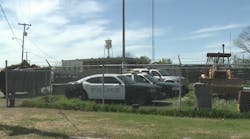By Debra-Lynn B. Hook
Tribune News Service
The base characteristics of a good parent are universal, rooted in love, patience and as much as anything, the instinct to protect.
This instinct is the same instinct that kept me up at night, watching my sick child’s chest move up and down, that makes a parent want to run onto the soccer field when their child is hurt, the same instinct I imagine to be on overdrive in Central America’s violent Northern Triangle, three countries riddled with poverty and government corruption, where gangs, extortionists and drug lords control the streets, where high rates of looting, smuggling, murder, rape rates mean innocent citizens fear for their lives.
This, too, I imagine, is the instinct that is driving thousands of desperate families north, away in particular from Guatemala, El Salvador and Honduras, with the hope of entry to the United States based on asylum, or protection from imminent danger, a globally held human right, according to the United Nation’s Universal Declaration of Human Rights.
And yet, in the waning days of spring this year, the courage of parents who dared to travel sometimes for days to our border, was not celebrated, not in the United States anyway. On the contrary, migrating families, many of them unaware of President Trump’s new zero-tolerance immigration policy that includes a crackdown on asylum, were met at the U.S. border thousands of miles from home with more trauma. This new hardship was reserved not only for the parents themselves, as the majority were taken to jail to await trial as a criminal under Trump’s new design, but for their decidedly innocent children, who were taken from them, often with no proper explanation why or where they were going, according to witness reports.
“It was inhumane,” public-policy scholar and immigration-enforcement expert Daniel Chand, a professor at Ohio’s Kent State University, told me recently. “A child who is already going though civil strife or civil war, or their family has been threatened or murdered, has already gone through a lot. Now he is in this new place and being separated from his mother.”
The practice of separating children from their migrant parents, which before this spring, according to multiple sources, was considered cruel and destructive and used rarely, but which became automatic under the Trump Administration, has since been ordered to stop.
News, photos and audio tapes of crying children wrapped in aluminum space blankets, while being held in large, chain-link holding pens, a practice the American Academy of Pediatrics deemed “toxic stress” with possible long-term traumatic effects, caused such national outrage among both Republicans and Democrats, that President Trump on June 20 issued an executive order halting the practice.
On June 26, Judge Dana M. Sabraw of the Federal District Court in San Diego demanded the same, along with orders for reunifying all 2,600 children with their parents by July 26.
Meanwhile, the inhumanity of the moment sticks to the Fourth of July air in the churlish words of U.S. Attorney General Jeff Sessions.
“If you don’t want your child separated, then don’t bring them across the border illegally,” said Sessions, as he announced the zero-tolerance policy in May. “It’s not our fault that somebody does that.”
Zero tolerance.
Zero humanity.
“Under past administrations,” Chand said, “there was more emphasis on enforcing the law in a humane way. That was the case with Obama and even W. Bush. I’m one-hundred percent confident saying that is not the case now.”
It’s unclear what will happen next with President Trump’s intent. Border patrol officers say zero-tolerance is dead for now: If immigration officials can’t legally separate children from their families, adults can’t automatically be criminalized and taken to jail. There aren’t enough detention facilities for immigrant offenders to begin with, or enough immigration judges to keep cases moving.
As for the least among us, the youngest people who are the unmistakable victims in this, while Judge Sabraw ordered that every child must have been in contact with a parent by July 6; that children under 5 must be reunited with their parents by July 10; that all children must be reunited with their parents by July 26, attempts at reunification present a bureaucratic nightmare with parents being processed under one agency and children, another; with parents being processed for deportation hearings before they find their children; with no official paper trail or documentation pointing to which of 100 detention centers their child was taken to, human-rights advocates said.
As of last week, only 522 of 2,600 separated children had been reunited with their families, according to the U.S. Department of Homeland Security, with the onus for further family reunions falling on the shoulders of bewildered parents.
“There is (often) no system in place to help them (parents) do this, and even with the help of a lawyer, it can be nearly impossible to move forward if the parent is in custody,” wrote Madeline Aggeler for New York Magazine.
Many organizations, such as KIND (Kids in Need of Defense), the Texas Civil Rights Project and RAICES (The Refugee and Immigrant Center for Education and Legal Services), which raised $20 million in part to help with reunification, are accepting volunteers to help with tasks that include legal intake and interviewing families.
Meanwhile, said a frustrated Chand, none of this should be happening. None of it would be happening if lawmakers had been more savvy about policy.
“You have ideologues with no experience in government, and you end up with these chaotic messes,” said Chand.
Besides which, Chand contended, zero tolerance is never a good idea, even if immigration controls may be.
“We typically enforce laws with compassion, and zero tolerance leaves no room for compassion. Zero tolerance is like anyone who goes 26 miles per hour gets a ticket for going one mile over the 25 speed limit, Chand said. “Zero tolerance loses sight of the intent of law, which is to protect people and to serve a greater purpose while causing no harm.”
Good parents have to hold themselves to impossible standards at times.
Good government should have to, too.
———
(Debra-Lynn B. Hook of Kent, Ohio, has been writing about family life since 1988. Visit her website at www.debralynnhook.com; email her at [email protected], or join her column’s Facebook discussion group at Debra-Lynn Hook: Bringing Up Mommy
———
©2018 Debra-Lynn B. Hook
Distributed by Tribune Content Agency, LLC.



